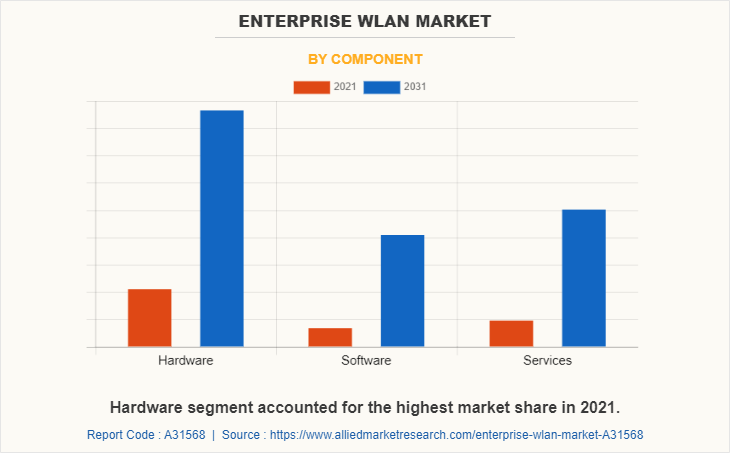Enterprise WLAN Market Insights, 2031
The global enterprise wlan market was valued at USD 7.4 billion in 2021, and is projected to reach USD 35.5 billion by 2031, growing at a CAGR of 17.3% from 2022 to 2031.
Increase in adoption of cloud based managed service and increase in demand from large enterprises boosts growth of the global enterprise WLAN market. In addition, rapidly increase in demand for wireless and smart devices positively impacts growth of the market. However, lack of standardization in enterprise and limited investments, owing to high prices of WLAN products hampers the enterprise WLAN market growth. On the contrary, increase in data traffic and demand for high-speed data connectivity is expected to offer remunerative opportunities for expansion of the market during the forecast period.

Enterprise WLAN is a coding platform that is used to conduct votes and elections firmly. It is a digital platform that conducts elections without using paper or a ballot. In addition, many secure choice platform vendors offer supportive vote management consulting services that facilitate organization's style and implement their choice procedures.
The report focuses on growth prospects, restraints, and trends of the enterprise WLAN market trends. The study provides Porter’s five forces analysis to understand the impact of various factors, such as bargaining power of suppliers, competitive intensity of competitors, threat of new entrants, threat of substitutes, and bargaining power of buyers on the enterprise WLAN market.
Segment Review
The enterprise WLAN market is segmented on the basis of by component, enterprise size, industry vertical, and region. On the basis of component, the market is categorized into hardware, software and service. On the basis of enterprise size, the market is bifurcated into large enterprises and SMEs. By industry vertical, it is classified into IT and Telecommunication, BFSI, Government, Education, Healthcare, Retail, Transport and Logistics, and Others. By region, the market is analyzed across North America, Europe, Asia-Pacific, and LAMEA.

In terms of component, the hardware segment holds the highest enterprise WLAN market share as it is used for high-speed internet connectivity in the specified coverage area. However, the software segment is expected to grow at the highest rate during the forecast period, owing to increase in need for improved network and other digital experiences among the end users across the globe.

Region wise, the enterprise WLAN market size was dominated by North America in 2021, and is expected to retain its position during the forecast period, owing to increase in need of high-speed internet for business due to shift of business toward digitization and availability of deployment of unlicensed and shared spectrum in organizations. However, Asia-Pacific is expected to witness significant growth during the forecast period, owing to strong economic growth of emerging countries in the region and ongoing development in the telecom sector.
The key players that operate in the enterprise WLAN market are Aerohive Networks, Alcatel Lucent Enterprise, Allied Telesis, Aruba Networks, Avaya Corporation, Cisco Systems, Inc., Dell Technologies Inc., Juniper Networks Inc., Ruckus Wireless, Huawei Technologies, Co. Ltd. These players have adopted various strategies to increase their market penetration and strengthen their position in the industry.
Top Impacting Factors
Increase in Adoption of Cloud-based Managed Services
Increase in adoption of cloud based managed service, and rising demand for IoT devices around enterprises drives the growth of the enterprise WLAN market. In addition, cloud managed platforms assist organizations in facilitating higher speed by deploying radio frequency-based solutions. Furthermore, several leading players are developing cloud platform to manage the internet and wi-fi connections around the globe, which, in turn, boost the growth of the market. Moreover, the increase in demand for network solutions for good work efficiency is expected to propel the growth of the enterprise WLAN industry during the forecast period.
Increase in Demand from Large Enterprises
Deployment of WLAN services in large enterprises is augmenting the overall market growth as an increasing volume of data utilization is generating a sturdy demand for improved premise mobility. The industry is expected to see new opportunities for continued connectivity for smooth business operations in large enterprises. In addition, to sustain the rapidly changing business requirements, including high bandwidth and low latency, the rising reliance on enterprise WLAN structures is positively influencing the growth of the industry. Furthermore, integration of solutions in WLAN services like traffic analyzer, performance monitoring, and configuration management allows organizations to solve issues like hyper-scale networks, which in turn is driving the growth of the enterprise WLAN market.
COVID-19 Impact Analysis
The global COVID-19 pandemic has drastically affected businesses across the world. It has affected positively on the adoption of enterprise WLAN solution due to lockdown imposed by governments of different countries. Employees have to work from home, which has increased the usage of cloud infrastructure and adoption of remote workspace application. This, in turn, is expected to result in increase in internet traffic. Global lockdown put restriction on the auction of WLAN spectrum, which delayed the implementation of enterprise WLAN. Post COVID-19 situation, companies are focusing on advanced technology, such as augmented reality, virtual reality, and internet of things, to perform contactless operation in the industry verticals, such as manufacturing, energy and utility, and others, which will drive the adoption of enterprise WLAN solutions globally.
The COVID-19 pandemic is anticipated to result in surge in implementation of industrial automation across various industry verticals, such as retails & e-commerce, manufacturing, healthcare, and other sectors, which will surge the demand for enterprise WLAN. In the first phase of COVID-19 pandemic, some countries, such as Germany, Italy, and the UK, in Europe were critically hit by COVID-19 due to which Wi-Fi deployment plans have been postponed or expected to be delayed. Furthermore, detection of large number COVID-19-positive cases in the LAMEA region has negatively impacted several investment activities, which are focused on smart city infrastructure, thereby affecting the deployment of industrial automation technologies.
On the contrary, in post COVID-19 situation in Asia-Pacific, the number of COVID-19-positive cases is increasing in emerging countries such as India and South Asian countries. Thus, these countries are expected to strengthen restrictions on public. Attributed to this reason, deployment activities of WLAN related facilities in this region are comparatively slower. Conclusively, the pandemic has both positive as well as negative impacts on the global enterprise WLAN industry.
Key Benefits for Stakeholders
- The study provides an in-depth analysis of the global enterprise WLAN market forecast along with current & future trends to explain the imminent investment pockets.
- Information about key drivers, restraints, & opportunities and their impact analysis on global enterprise WLAN market trend is provided in the report.
- The Porter’s five forces analysis illustrates the potency of the buyers and suppliers operating in the industry.
- The enterprise WLAN market analysis from 2022 to 2031 is provided to determine the market potential.
Enterprise WLAN Market Report Highlights
| Aspects | Details |
| Market Size By 2031 | USD 35.5 billion |
| Growth Rate | CAGR of 17.3% |
| Forecast period | 2021 - 2031 |
| Report Pages | 245 |
| By Component |
|
| By Enterprise Size |
|
| By Industry Vertical |
|
| By Region |
|
| Key Market Players | Allied Telesis, Inc., ALE International, Aerohive Networks (Extreme Networks), Ruckus Networks (CommScope), Juniper Networks, Inc., Cisco Systems, Inc., Huawei Technologies, Co. Ltd., Avaya Inc., Aruba Networks (Hewlett Packard Enterprise Development LP), Dell Technologies Inc. |
Analyst Review
An enterprise WLAN network is a collection of Wi-Fi Access Points (AP) and is characterized by high-quality security and performance, centralized management, and an advanced capacity for user density. In addition, in enterprise WLAN, an access point is a device that allows wireless devices such as smartphones and tablets to connect with a wired network using Wi-Fi. Moreover, enterprise WLAN networks provide enterprise with several benefits such as improved performance, better security, and reduced costs.
The global enterprise WLAN market is expected to register high growth, owing to rise in demand for IoT devices and wireless connectivity is likely to fuel market development. Thus, increase in adoption of enterprise WLAN, owing to its security is one of the most significant factors drive growth of the market. With surge in demand for enterprise WLAN, various companies have established alliances to increase their capabilities. For instance, in June 2022, Cellnex Telecom partnered with Nokia commitment in bringing private wireless networks to enterprise customers.
In addition, with further growth in investments across the world and rise in demand for enterprise WLAN, various companies have expanded their current product portfolio with increased diversification among customers. For instance, in May 2021, Aruba a Hewlett Packard Enterprise company launched market’s first enterprise-grade Wi-Fi 6E solution set – the 630 Series of campus access points (APs), starting with the AP-635*. The latest innovation in Wi-Fi technology, Wi-Fi 6E refers to Wi-Fi devices that operate in the 6 GHz band it will help organizations better support critical activities like videoconferencing, telemedicine, and distance learning.
Moreover, with increase in competition, major market players have started acquisition companies to expand their market penetration and reach. For instance, April 2022, Great Hill Partners, acquired MetaGeek to create signific business to enable IT departments to provide support for home networks for employees.
The global enterprise WLAN market was valued at USD 7.4 billion in 2021, and is projected to reach USD 35.5 billion by 2031
The enterprise WLAN market is projected to grow at a compound annual growth rate of 17.3% from 2021-2031 to reach USD 35.5 billion by 2031
The key players profiled in the report include Alcatel Lucent Enterprise, Allied Telesis, Aruba Networks, Avaya Corporation, Cisco Systems, Inc., Dell Technologies Inc., Juniper Networks Inc., Ruckus Wireless, and Huawei Technologies, Co. Ltd.
North America held the largest market share
Increase in adoption of cloud based managed service and increase in demand from large enterprises is boosting growth of the global enterprise WLAN market. In addition, rapidly increase in demand for wireless and smart devices positively impacts the growth of the enterprise WLAN market.
Loading Table Of Content...



